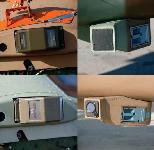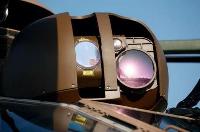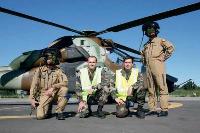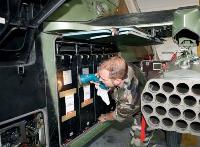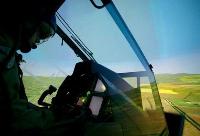Фотографии
-
By December 2012, no fewer than 50 Mi-28Ns were reported to have been delivered to the Russian Air Force Army Aviation Branch operated by one training centre and two front line air bases.
Самолёты на фотографии: Миль Ми-28 - Россия - 1982
-
Самолёты на фотографии: Миль Ми-28 - Россия - 1982
-
Mi-28N, serial 38, operated by Mil MHP, is seen during a mountain flight test programme in the Caucasus Mountains in August 2010, carrying four 557-litre external tanks, a configuration used for ferry flights. Later on, this machine was converted into the Mi-28NE export configuration and performed demo flying in India and Algeria.
Самолёты на фотографии: Миль Ми-28 - Россия - 1982
-
Самолёты на фотографии: Миль Ми-28 - Россия - 1982
-
Регистрационный номер: RF-95653 Mi-28N RF-95653 is operated by the Russian Air Force Army Aviation's 334th Combat Training and Aircrew Conversion Centre at Torzhok north of Moscow. The centre undertakes pilot and weapons system operator conversion training and also develops new combat employment tactics, techniques and procedures.
Самолёты на фотографии: Миль Ми-28 - Россия - 1982
-
A pair of Strelets launcher units each loaded with four 9M39 Igla-V air-to-air missiles can be seen suspended under the outer port pylon of this early-production Mi-28N used for development work by Mil MHP. The outer starboard pylon carries six 9M120 Ataka-V air-to-ground missiles.
Самолёты на фотографии: Миль Ми-28 - Россия - 1982
-
Регистрационный номер: RF-93942 Mi-28N RF-93942 seen at Klin during rehearsals for the Russian Air Force 100th anniversary airshow in August 2012.
Самолёты на фотографии: Миль Ми-28 - Россия - 1982
-
Регистрационный номер: RF-95648 The Mi-28N is routinely employed on the battlefield in two-ship formations for close air support and anti-tank missions.
Самолёты на фотографии: Миль Ми-28 - Россия - 1982
-
This image gives a good view of the radar-equipped Mi-28NE export derivative as offered to Algeria in 2011. At the front is the 'pimple' antenna used to guide the 9M120 Ataka-V missile. Below is the GOES-520 turret used for night flying, and the Tor-N targeting sensor housed in a drum-shaped turret with two optically flat windows. The massive turret containing the Shipunov 2A42 30mm cannon is at the bottom.
Самолёты на фотографии: Миль Ми-28 - Россия - 1982
-
A new dark grey camouflage was introduced by the Army Aviation in October 2011 as seen on this Mi-28N operated by the Torzhok-based 334th Combat Training and Aircrew Conversion Centre.
Самолёты на фотографии: Миль Ми-28 - Россия - 1982
-
The AH-1W's fuselage is fitted with sensors for the AN/AAR-47(V)2 missile warning receiver, AN/APR- 39(V) pulse radar warning receiver, AN/APR-44(V) continuous wave radar warning receiver and AN/AVR-2 laser warning receiver. The latter system warns the crew when it detects pulsed laser light.
Самолёты на фотографии: Bell AH-1W / AH-1Z Super Cobra - США - 1983
-
Самолёты на фотографии: Bell AH-1W / AH-1Z Super Cobra - США - 1983
-
This AH-1W is armed with 2.75-inch Hydra 70 rockets mounted in a seven-tube LAU-68 launcher and two AGM-114 laser-guided Hellfire missiles mounted on M272 launchers.
Самолёты на фотографии: Bell AH-1W / AH-1Z Super Cobra - США - 1983
-
An AH-1W SuperCobra assigned to HMLA-267 'Stingers' takes off from Camp Bastion on a close air support mission.
Самолёты на фотографии: Bell AH-1W / AH-1Z Super Cobra - США - 1983
-
AH-1Ws form part of each Marine Expeditionary Unit and deploy aboard US Navy landing assault ships.
Самолёты на фотографии: Bell AH-1W / AH-1Z Super Cobra - США - 1983
-
Mounted on the nose of the AH-1W, the AN/AWS-1(V)1 Night Targeting System integrates a FLIR sensor for automatic target tracking, a laser designator rangefinder, TV sensor and video recorder.
Самолёты на фотографии: Bell AH-1W / AH-1Z Super Cobra - США - 1983
-
The AH-1W SuperCobra's M197 three-barrel 20mm cannon is mounted in the A/A49E-7(V)4 turret with 750 rounds of ammunition.
Самолёты на фотографии: Bell AH-1W / AH-1Z Super Cobra - США - 1983
-
A mechanic signals to the crew during post-flight inspections at Camp Bastion in Afghanistan.
Самолёты на фотографии: Bell AH-1W / AH-1Z Super Cobra - США - 1983
-
The AH-1W's prominent exhausts are linked to the 1,690 shp GE-T700-401 engines.
Самолёты на фотографии: Bell AH-1W / AH-1Z Super Cobra - США - 1983
-
Самолёты на фотографии: Bell AH-1W / AH-1Z Super Cobra - США - 1983
-
Note the AN/ALE-39 countermeasures dispenser set above the stub-wing. Each of the two MX-7721 chaff dispensers holds 30 cartridges.
Самолёты на фотографии: Bell AH-1W / AH-1Z Super Cobra - США - 1983
-
Регистрационный номер: ES1016 The primary sensor of the first generation Apache is the Target Acquisition Designation Sight/Pilot Night Vision Sensor mounted on the nose of the helicopter.
Самолёты на фотографии: McDonnell Douglas AH-64 Apache - США - 1975
-
Регистрационный номер: ES1020 AH-64A Apache ES1020 (c/n PV-895, ex 92-0481) on the ramp at Stefanovikio.
Самолёты на фотографии: McDonnell Douglas AH-64 Apache - США - 1975
-
Регистрационный номер: ES1027 Самолёты на фотографии: McDonnell Douglas AH-64 Apache - США - 1975
-
Ground crew preparing a 1st TEEP Apache crew for launch.
Самолёты на фотографии: McDonnell Douglas AH-64 Apache - США - 1975
-
Регистрационный номер: ES1014 AH-64A+ Apache ES1014 (c/n PV-889, ex 90-0537) passes by the tower at Stefanovikio, with a line up Hueys in the distance.
Самолёты на фотографии: Bell UH-1D Iroquois / Model 205 - США - 1961McDonnell Douglas AH-64 Apache - США - 1975
-
The Hellenic Apache fleets are protected from missile threats by the HIDAS system, which uses sensors mounted on the front and mid-section of the fuselage, with countermeasure dispensers towards the rear
Самолёты на фотографии: McDonnell Douglas AH-64 Apache - США - 1975
-
The terrain of Greece is ideal for attack helicopters, in that it provides plenty of cover from detection from radar for low flying aircraft.
Самолёты на фотографии: McDonnell Douglas AH-64 Apache - США - 1975
-
The Apache fleets are extremely active. According to a 1st TEEP pilot, "Alongside our 'standard' daily missions we have maintenance flights booked most days, as well as 'readiness' flights, which are a critical part of our operational status and flying schedule”
Самолёты на фотографии: McDonnell Douglas AH-64 Apache - США - 1975
-
Ground crew load a 2.75-in (70-mm) Hydra rocket into a M261 pod. The weapon is used by both variants of the Apache in HAA service. The AH-64A also employs the AGM-114F/K and KBF versions of the Hellfire II.
Самолёты на фотографии: McDonnell Douglas AH-64 Apache - США - 1975
-
Colonel Theodoros Kapetanios, former commanding officer of 1st TEEP, in the rear cockpit of an AH-64A.
Самолёты на фотографии: McDonnell Douglas AH-64 Apache - США - 1975
-
Самолёты на фотографии: Eurocopter PAH-2 / EC.665 Tiger - International - 1991
-
Tigre HAP and HAD are both day and night time capable.
Самолёты на фотографии: Eurocopter PAH-2 / EC.665 Tiger - International - 1991
-
Регистрационный номер: F-ZWBP [5] Tigre HAD prototype No.5001 (Spanish HAD E01) was extensively used during the trial programme.
Самолёты на фотографии: Eurocopter PAH-2 / EC.665 Tiger - International - 1991
-
Регистрационный номер: F-ZWBP [5] Tigre HAD prototype No.5001 manoeuvring at very low level.
Самолёты на фотографии: Eurocopter PAH-2 / EC.665 Tiger - International - 1991
-
Регистрационный номер: F-ZWBP [5] Tigre HAD prototype No.5001 at low-level during a test flight from Cazaux in south west France. The Tigre HAD will offer the French Army many more capabilities and will allow the faithful Gazelle to be withdrawn from service.
Самолёты на фотографии: Eurocopter PAH-2 / EC.665 Tiger - International - 1991
-
A view of the MTR390-2C turbine engine used by the Tigre HAP.
Самолёты на фотографии: Eurocopter PAH-2 / EC.665 Tiger - International - 1991
-
The Tigre HAD’s weapon system has been extensively reworked to accept new anti-tank missiles. This shot shows the aircraft loaded with two Mistral air-to-air missiles (outer pylon) and two each of the Spike ER (top inner pylon) and AGM-114 Hellfire (bottom inner pylon). Orange test cameras are also fitted.
Самолёты на фотографии: Eurocopter PAH-2 / EC.665 Tiger - International - 1991
-
Tigre HAD test pilots and a flight-test engineer.
Самолёты на фотографии: Eurocopter PAH-2 / EC.665 Tiger - International - 1991
-
ALAT’s flying school at Le Luc in the south of France is where all French and German Tigre aircrews undergo conversion training.
Самолёты на фотографии: Eurocopter PAH-2 / EC.665 Tiger - International - 1991
-
Eurocopter claims that the Tigre's 30mm gun is the most accurate helicopter cannon in service anywhere. A derivative of this cannon was selected for the now-cancelled American RAH-66 Comanche.
Самолёты на фотографии: Eurocopter PAH-2 / EC.665 Tiger - International - 1991
-
The camouflage selected by the French Army for its Tigre HAPs has proved extremely effective in a wide variety of environments.
Самолёты на фотографии: Eurocopter PAH-2 / EC.665 Tiger - International - 1991
-
Four radar warning receiver sensors provide hemispheric coverage.
Самолёты на фотографии: Eurocopter PAH-2 / EC.665 Tiger - International - 1991
-
Tigre HAD prototype No.5001 loaded with two Mistral air-to-air missiles (outer pylon), two Spike ERs (top inner pylon) and two AGM-114 Hellfires (bottom inner pylon) during flight testing at Cazaux. Orange test cameras are also fitted.
Самолёты на фотографии: Eurocopter PAH-2 / EC.665 Tiger - International - 1991
-
Регистрационный номер: F-ZWBP [5] With high-speed cameras fitted all over the airframe, Tigre HAD prototype No.5001 is shown configured for a Hellfire missile launch during a test flight from Cazaux in south west France.
Самолёты на фотографии: Eurocopter PAH-2 / EC.665 Tiger - International - 1991
-
Регистрационный номер: F-ZWBP [5] Tigre HAD prototype No.5001 (Spanish HAD E01) was extensively used during the trial programme.
Самолёты на фотографии: Eurocopter PAH-2 / EC.665 Tiger - International - 1991
-
Fitted with four 68mm rocket launchers (giving a total weapons load-out of 68 rockets), the Tigre boasts considerable firepower against troops, light vehicles and other soft targets, as demonstrated in Afghanistan.
Самолёты на фотографии: Eurocopter PAH-2 / EC.665 Tiger - International - 1991
-
In the Tigre, the pilot sits in the front seat and the weapon system operator in the back seat.
Самолёты на фотографии: Eurocopter PAH-2 / EC.665 Tiger - International - 1991
-
Fitted with two external fuel tanks on the inboard stations, the Tigre HAP's combat range is extended from 800 to 1,300km.
Самолёты на фотографии: Eurocopter PAH-2 / EC.665 Tiger - International - 1991
-
Top left and bottom left: Close-up on the HAD's laser warning detector/laser warning receiver mounted at the 'wing tip'.
Top right: The Tigre electronic warfare suite/self-defence suite proved its worth in Libya.
Bottom right: The HAD's electronic warfare suite/self-defence suite has been improved.Самолёты на фотографии: Eurocopter PAH-2 / EC.665 Tiger - International - 1991
-
Architecture of the Strix roof-mounted sight on the Tigre HAD has been altered to fit the laser designator needed for the Hellfire missile.
Самолёты на фотографии: Eurocopter PAH-2 / EC.665 Tiger - International - 1991
-
ALAT aircrews and maintainers are all trained to an extremely high standard.
Самолёты на фотографии: Eurocopter PAH-2 / EC.665 Tiger - International - 1991
-
An ALAT engineer checks the ammunition storage boxes used for the Nextec 30M781 30mm cannon.
Самолёты на фотографии: Eurocopter PAH-2 / EC.665 Tiger - International - 1991
-
The Nextec 30M781 30mm cannon has a firing rate of 750 rounds per minute and is mounted in a THL 30 turret fitted under the chin.
Самолёты на фотографии: Eurocopter PAH-2 / EC.665 Tiger - International - 1991
-
The TopOwl helmet-mounted display was significantly improved for the Tigre HAD.
Самолёты на фотографии: Eurocopter PAH-2 / EC.665 Tiger - International - 1991
-
The ALAT school at Le Luc uses high fidelity simulators.
Самолёты на фотографии: Eurocopter PAH-2 / EC.665 Tiger - International - 1991
-
Самолёты на фотографии: McDonnell Douglas AH-64D Apache Longbow - США - 1991
-
The AH-64DHA (seen here) has more powerful engines than the AH-64A. The infrared suppression system in the exhaust helps reduce the helicopter's vulnerability to missiles.
Самолёты на фотографии: McDonnell Douglas AH-64D Apache Longbow - США - 1991
-
Самолёты на фотографии: McDonnell Douglas AH-64D Apache Longbow - США - 1991
-
While the radar makes the 'D' easily distinguished from the As', not all the fleet is equipped with it
Самолёты на фотографии: McDonnell Douglas AH-64D Apache Longbow - США - 1991

















































